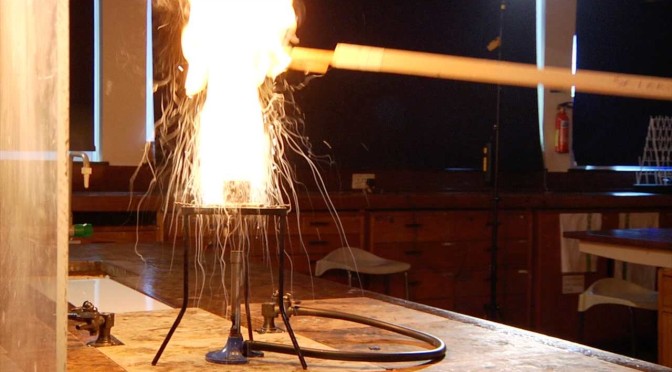No other film in this series provoked more discussion and argument than this. Mostly from me. It’s a classic demo and was highly-requested in the nomination stage of Get Set Demonstrate, yet I argued against filming it.
For many years I made essentially all the science programmes that went out during the UK’s teatime ‘children’s television’ window, and there were only a few demonstrations I flat-out refused to show. This was one of them. You can show a safe method, you can treat the science with due respect… but with video you have precious little knowledge of your audience. You can’t tell when their attention has drifted away and they’ve maybe missed a crucial detail, you can’t be 100% certain of the message they take home, and most importantly you can’t guess what they might be tempted to try for themselves.
In person, the heat from the fireball is impressive: on video, it’s the size of your TV, or a YouTube window, or your phone. And it’s cold.
Film-makers can’t be responsible for the behaviour of their audience (discuss, 20 marks), but in this case the risk is very, very high. If 100,000 children saw the demo in our show, and 1 in 1,000 tried it themselves, and 1 in 100 set the curtains alight… that’s not something I ever wanted on my conscience. It’s not that the demo is too dangerous, it’s that it’s too easy. It’s trivial to perform it yourself in a kitchen, and the results can (and will) be catastrophic. So I never filmed the demo. Until now.
Others on the team eventually convinced me, using effectively the same argument applied backwards. The demo is straightforward to reproduce, and reproducing it is dangerous. Knowing that – understanding how and why oil fires are dangerous – might just save someone’s life, and for that reason alone, the team argued, this demo should be known and used in schools, and hence we should make this film.
I’m glad we did.
Three quick notes:
- In a UK school, follow the CLEAPSS guidance (Scotland: SSERC). As a teacher or technician you should consult CLEAPSS as a matter of routine before attempting hazardous activities, and where they issue standard guidance (as here): follow it. ScienceDemo.org doesn’t have access to the CLEAPSS archive so we can’t link directly to the resource, sorry, but you’ll find it easily enough.
- The formal government advice on how to react to a chip pan fire in the home is: get out, stay out, and call 999. It’s no longer considered appropriate to attempt the ‘damp tea-towel’ remedy yourself: the casualty rate is too high. We should have mentioned this in the film.
- In person, our fires were a little underwhelming, with the water often putting the flame out quickly. We’ve cut around that for the film, but speaking to other demonstrators subsequently it seems we were probably more assiduous than strictly necessary about turning the gas off the instant the flame caught. Give it a few more seconds and you’ll get a more satisfying fireball, we’re told. Do see Bob Worley’s comment below about one-upmanship, however!
 This film was produced for the Get Set Demonstrate project. Click through for teaching notes, and take the pledge to perform a demonstration to your students on Demo Day, 20th March 2014.
This film was produced for the Get Set Demonstrate project. Click through for teaching notes, and take the pledge to perform a demonstration to your students on Demo Day, 20th March 2014.

